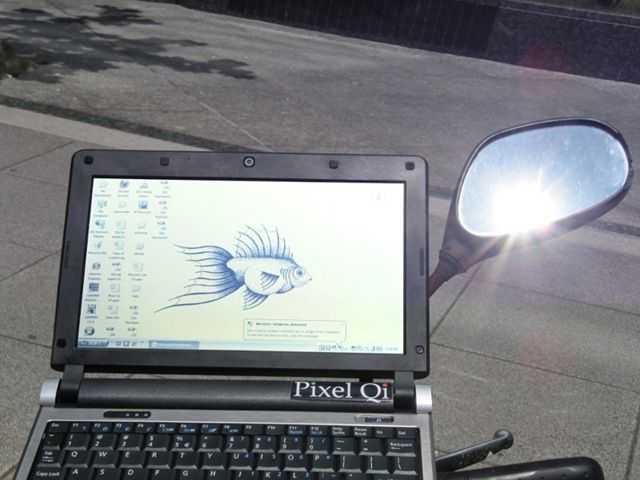
Posted on 26 November 2009
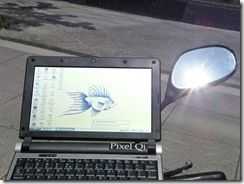 While Intel, AMD, ARM and VIA might want you to believe that low-power silicon is the answer to all battery life problems, the truth is somewhat different. We’re at a point now where all silicon, be it X86 or RISC-based, can perform at low enough power consumption that other components on a device become more significant in the power, heat and battery life equation. Talk about ‘Ãdle’ power drain is irrelevant when you’re using a device in constantly-connected mobile computing scenarios.
While Intel, AMD, ARM and VIA might want you to believe that low-power silicon is the answer to all battery life problems, the truth is somewhat different. We’re at a point now where all silicon, be it X86 or RISC-based, can perform at low enough power consumption that other components on a device become more significant in the power, heat and battery life equation. Talk about ‘Ãdle’ power drain is irrelevant when you’re using a device in constantly-connected mobile computing scenarios.
Two of the main power problems are the wireless radios (chattery 3G transmissions being a huge problem) and the screen. Despite improvements in backlight technology, a small 3.5 inch LCD screen still takes about 0.5 watt when fully backlit. A 10 inch netbook screen will take up to 3 watts. If you’re just reading text, that backlight is taking way over 50% of the total battery drain and as we move to lower-power silicon platforms, the percentage rises higher. This is a particular problem for mobile users as we tend to moving about in different lighting situations and tend to pump the backlight up higher than desk-bound users.
One of the solutions that many have been watching closely for the last year is the technology developed by Pixel Qi. The trick they use is rather simple. They reflect ambient light back through the LCD matrix to reduce the need for backlight. This works indoors and out. The implementation more complex than that of course but the result is that in bright ambient light situations, you will see a big reduction in backlight power drain. The contrast and pixel density is also said to produce e-ink style results too so it could help to make screens more comfortable to read. Pixel Qi have even kept the process fairly cheap to implement by using existing technologies. Win win win!
Screens up to 10 inchare going into mass production right now and we should see the first devices before the end of the year. Expect products to reach customers in 3-6 months based on the time it usually takes new products to reach the market. As for prices, I’m guessing the marketing teams will use this to throw another $50 on a standard netbook price for a ‘sunlight readable’ version but overall, you should see about 10-20% improvement in battery life on a standard netbook. As we move forward with lower power platforms and radios, the advantage goes up and I see this sort of technology becoming the norm rather than something that is offered as a premium upgrade.
I’m looking forward to testing out a nice thin 7 inch ultra mobile PC with this tech. Not that I need to read for 7-10 hours between charges but keeping that battery over 50% full always gives one a better feeling when mobile.
Via
Source
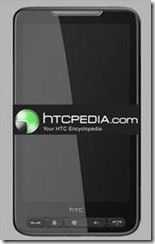
Posted on 01 October 2009
A few months ago I took hold of the 4.1 inch Toshiba TG01 and said no! It’s too big for my pocket.
It’s the size that really struck me. For a phone, it’s HUGE! There’s simply no way that the average person is going to be able to use this as a 24/7 phone. I don’t mean to imply that the TG01 is meant to be a 24/7 phone but it proves that convergence between the full internet minimum screen resolution of 800×480 and the 24/7 total convergent device is simply not going to happen for most people.
Yesterday, following news on the HTC Leo, a Snapdragon powered 4.3 inch slate phone that we covered a while back, WMPoweruser asks the same question.
It seems that most of you readers really are happy with big screen devices.
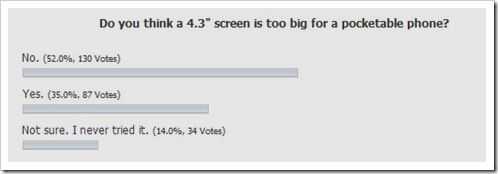
52% of UMPCPortal readers voted ‘No’ 4.3 inch is not too big for a pocketable phone.

64% of WMPowerUser readers voted ‘No’ 4.3 inch is not too large on the HTC Leo.
This drive for convergence doesn’t bring me any closer to my ideal 3-device strategy but I’m happy to accept that there are a ton of people out there that want ONE device to cover phone, MID, navigation, camera and a certain amount of productivity tasks. All I can say is that that the voting numbers probably represent a niche of high-end gadget and mobility users and that I fit into a class of people that doesn’t wear cargo pants!
On a serious note though, I find this drive for convergence a bit cheap from a marketing perspective. I think the long-term practicalities of converged devices are limited, that quality suffers due to physical constraints and that eventually, people end up buying dedicated tools for their tasks anyway. The marketing people just want you to THINK that it can do everything. Don’t they?
I’m guessing we’ll have a good discussion about this below and that someone will say – ‘the best camera/pnd/pmp/umpc/mid is the one you have with you.’ You have a good point. I’m off to have another sleepless night over the matter.
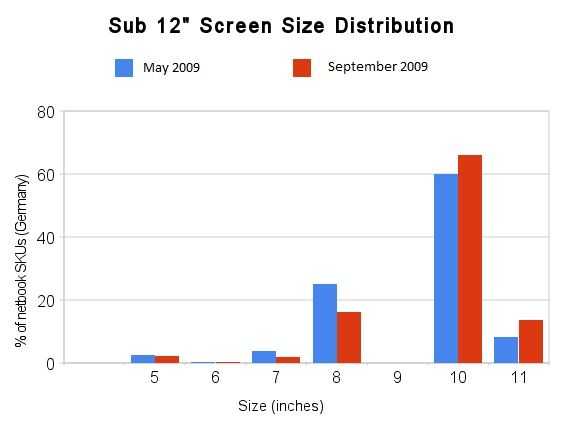
Posted on 07 September 2009
Back in May, I took a look at the small notebook PC market to try and determine the distribution of screen sizes. I took screen sizes of 11 inch and under and plotted them on a graph to find the unsurprising result that the 10 inch screen size was the most popular and the original 7 inch netbook had all but died. In May 2009, 68% of the devices had a screen that was over 10 inch. I also promised to revisit the subject. By taking a second snapshot today, I’m able to work out what sizes are growing and waning in popularity. It’s only a second data point but it’s very interesting.
There has been a huge growth in the 11 inch segment (and 12 inch but that’s out of scope for this mobile-computing-focused data set) which means that of all the SKUs, 79.6% are now 10 inch and over.

- 79% of devices have screens of 10 inch and over. (was 68%)
- The 11 inch segment grew by 65%
- The 5, 6, 7 and 8 inch segments all declined in % (and absolute number of devices available)
- The 8 inch segment declined by over 40% from 61 devices down to 45
- Linux-based devices still count for 8.5% of the devices (no change)
- 80% are over 1KG (12% increase)
- Nearly all netbooks under 1KG are 1st-gen devices that are outgoing.
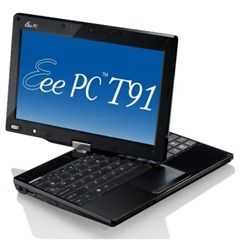 The sample size is 279 (up from 243)
The sample size is 279 (up from 243)- The cheapest device in the segment is the Hercules eCafe EC-800 based on the AMD Geode CPU. 160 Euros. Hercules also make the cheapest Atom-based device, the EC-900, for 190 Euros.
In general it’s a sad story for mobile computing fans especially as some of the best ultra-mobile solutions aren’t even reaching the normal online channels but there’s one shining star in amongst that lot. The ASUS EeePC T91 for 450 Euros, in Black, with a 24-month guarantee. 960gm, 5hrs battery life and a whole lot of flexibility!
As before, the results are based on data from the German/Austrian price comparison engine Geizhals.at and include all notebooks (and almost insignificant numbers of tablets and UMPCs) with screen sizes equal-to or below 11 inch. Again, I’ve put a note in my calendar to review the situation in 3-4 months time.
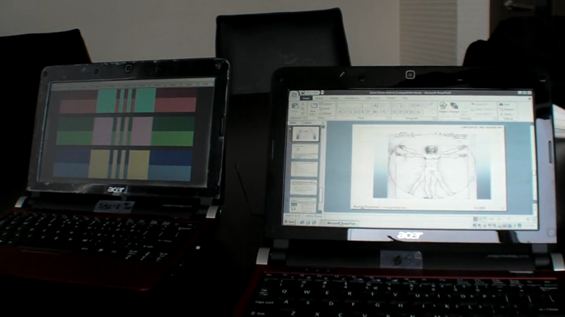
Posted on 02 June 2009
 We’ve been hearing rumblings of this for a while now, but it seems that Pixel Qi is now showing its new dual mode power saving screens. Based on the screen featured in the OLPC project’s XO computer. Essentially Pixel Qi has designed an LCD screen which can display just like you would expect a standard screen to do, but it can also toggle to an E-Ink like mode which uses ambient light to display the on screen image rather than a backlight.
We’ve been hearing rumblings of this for a while now, but it seems that Pixel Qi is now showing its new dual mode power saving screens. Based on the screen featured in the OLPC project’s XO computer. Essentially Pixel Qi has designed an LCD screen which can display just like you would expect a standard screen to do, but it can also toggle to an E-Ink like mode which uses ambient light to display the on screen image rather than a backlight.
What are the implications for the mobile device user? The screen is one of the single largest power consuming components of modern mobile devices. The ability to turn off the backlight and still be able to see the screen from ambient light would mean large power savings. With the XO laptop, the screen was actually able to stay active while the motherboard turned off. However, modern netbooks are running much different operating systems and hardware than the XO, and aren’t yet designed to be able to accomplish that extra power saving step. The dual mode means that you can still have a full color display at the flip of a switch, then go to the power saving backlight off mode which reads great in direct sunlight and also saves battery life. If Pixel Qi can keep these screens to a reasonable price, I think we’ll see them popping up on netbooks once they hit full production, but the power saving isn’t going to be mind-blowing.
A few things garnered from the following video. You’ll notice that they are demoing the first batch of their screens on what appears to be an Acer Aspire One D150 [Portal page]. It is mentioned that they are stock Acer’s bought online, then modified to work with the new screen. It doesn’t sound like this technology will be coming to our favorite touchscreen devices any time soon as the particulars of touchscreen technology don’t play nice with the visual quality of the Pixel Qi dual mode screen.
If you’ve used a Kindle, you probably know that the refresh rate is rather abysmal compared to a computer screen that you might be used to. I was impressed to see that the transreflective (E-Ink like) mode of the Pixel Qi screen actually retains a rather good refresh rate meaning that you can work just like you would normally even with that mode enabled (they even show a video being played). If it were E-Ink, you would need to toggle out of the mode just to see the mouse move at a reasonable rate.
Take a look a the video below to see the Pixel Qi screen in action:
[CrunchGear]

Posted on 16 February 2009
Update. This article is incorrect.
As CPU and chipset power consumption becomes less and less in phone and MID designs, the power drains of the displays, radio, peripherals and storage technology become more and more significant. One of the biggest issues, display backlighting, has been something that many people have been working on for a long time. In current high-brightness UMPCs and MIDs the screens can take up to 50% of the total power of the devices, which is exactly the scenario you’re in when you’re mobile.
LG will be tackling this issue on their Moorestown phone in 2010 by using a reflective, bi-stable technology from Mirasol Displays, a subsiduary of Qualcomm. It’s complex and vastly different from current backlit screen technologies but I can summarise by saying that it takes a lot less power, provides much more effective outdoor brightness and, due to it’s transflective nature, is easier on the eye. The method used is known as Interferometric MODulation (IMOD.)
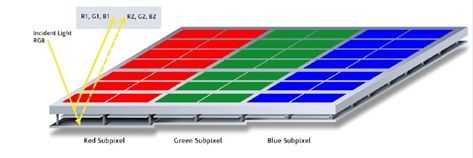
Mirasol IMOD Structure
There are some white papers and overviews on the Mirasol website which I have been through to try and get a feel for the power savings and although there aren’t any real figures given (obviously it depends on the size of the display) my gut feeling here is that in 3-5″ devices in bright room conditions, it could save 0.5 – 1W which will be extremely significant in the LG device which may only have a 2-3W profile. If you want to get a feel for the technology, take a look at this PDF which alludes to newspaper reading quality in terms of contrast and reflectivity. There’s also a very good video presentation here which the problems of traditional backlit displays and the ‘on-time’ that I’ve been highlighting recently.
It appears that current Mirasol products are currently quite small in size and obviously the technology is going to be more expensive so we might see this used as a secondary or external display (as in the two screen Nokia E90 design) but with 12-18 months to go before the product needs to be ready, Mirasol may be able to get a full 800×480 screen out.
Source
Mirasol website.

Posted on 25 November 2008
Here is a pretty cool video of what appears to be a working screen that is playing back video while the bezel that encapsulates is folds in half. This is just a concept from Samsung right now and probably has lots of technical limitations; it is probably still many years away. If technology like this can be squeezed into pocket sized devices, it could mean some pretty amazing displays on MIDs that don’t have any issue with folding up and going with you in your pocket during your day to day travels.
[GottaBeMobile]

Posted on 23 October 2008
According to my stats, 5.77% of vists to the UMPCPortal are from people with screen sizes of 1024×600, 800×480 or 800×600. Those screen sizes are almost exclusive to the ultra mobile PC (MID, pro-mobile, netbook) class of devices so its got be close to a 1:1 relationship.
I wonder if that same 5.77% statistic will appear if I put a poll here.
Look at the growth of the 1024×600 screens. Its not just cross-sector growth either. The 800×480 graph isn’t going anywhere!



Posted on 06 December 2007

This setup looks familiar!! Mini PC, Solar panel battery pack. The only difference here to my UMPC setup is that the CPU and screen are in separate units.
The Aleutia E1 is billed as the ‘ultimate off-grid computer’ by the London based company and they also offer the complete solution as an ‘office in a box’ package.
I have a few issues with the package though. First, the PC itself is running on a very low end 200Mhz, unspecified ‘X86’ processor. Secondly, the screen they’re using can take up to 10W. With the PC taking up to 8W, the whole solution seems fairly heavyweight compared to a UMPC-based solution.
I’ve just been testing an HTC Shift which has the 7″ 800×480 screen and can run Vista with Aero at an average 8.5w with the Wifi on! The AMD-based Kohjinsha SA1 averages even less and if you managed to get hold of an XO Laptop through he OLPC’s G1G1 program, you’d be averaging something like 3W drain giving you 6-times the run-time of this solution – with twice the processor speed!
On the plus side though, the complete solar office solution comes in at under 500 pounds sterling. That’s not bad at all.
Via LinuxScrew. Thanks Klaus.
 While Intel, AMD, ARM and VIA might want you to believe that low-power silicon is the answer to all battery life problems, the truth is somewhat different. We’re at a point now where all silicon, be it X86 or RISC-based, can perform at low enough power consumption that other components on a device become more significant in the power, heat and battery life equation. Talk about ‘Ãdle’ power drain is irrelevant when you’re using a device in constantly-connected mobile computing scenarios.
While Intel, AMD, ARM and VIA might want you to believe that low-power silicon is the answer to all battery life problems, the truth is somewhat different. We’re at a point now where all silicon, be it X86 or RISC-based, can perform at low enough power consumption that other components on a device become more significant in the power, heat and battery life equation. Talk about ‘Ãdle’ power drain is irrelevant when you’re using a device in constantly-connected mobile computing scenarios.
























